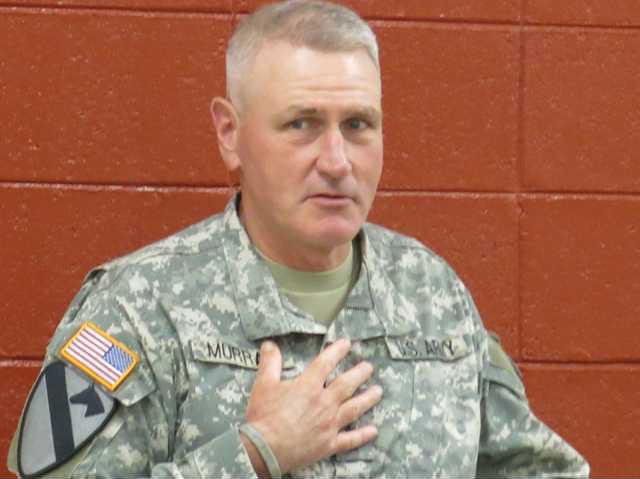The commander of the 3rd Infantry Division and Fort Stewart-Hunter Army Airfield shared lunch and comments Wednesday with the Coastal Georgia chapter of the Association of the U.S. Army at the Performing Arts Center in Flemington.
Maj. Gen. Mike Murray told AUSA members and community leaders that the most important decisions about Stewart-Hunter personnel cuts have not yet been made.
Murray said that for the last few years, the Army has been drawing down from a wartime high of about 550,000 active-duty soldiers to 490,000 soldiers. To make those reductions, the Army had to give up some of its brigade combat teams, one from each installation that had multiple BCTs.
“The BCT to the Army is like the air wing is to the Air Force,” Murray said, explaining that a BCT has huge logistical and combat capabilities. “(Although we’re losing the 2nd brigade), we’ve added an additional combat battalion to the remaining brigades, and we’ve restructured our engineer brigade.”
Murray said that while the 2nd ABCT continues toward inactivation, its soldiers continue to train. Starting this summer, most of the brigade’s infantry, artillery and engineer soldiers will be distributed among the 1st ABCT and the 4th Infantry Brigade Combat Team. Normal attrition will continue via retirement, expiration of term of service or permanent change-of-station moves. He said the Spartan brigade will have its official inactivation in January.
The commander said there is some discussion about reducing the active-duty Army from 490,000 to 450,000 or even 420,000. He said if that happens, the Army will have fewer soldiers than it had prior to World War II and more BCTs will be slashed.
“Once you lose a BCT, it’s very difficult to get it back,” he said. “Right now, (the Army) has 32 BCTs. Last time, we offset the loss (of 2nd ABCT) with (an additional battalion) and authorized over-strengths in remaining brigades ... If we had not had to give up 2nd brigade, we’d have 2,000 additional soldiers. If the 1st ABCT is taken, that’s another 4,500 soldiers.”
He said the Army also is looking at reducing the size of each division’s headquarters battalion. Murray said the Army will conduct another probable environmental assessment next month. Army leaders will visit each installation.
He added, though, that Stewart-Hunter has strategic value that might mitigate some of the losses, noting that Stewart is the largest Army base east of the Mississippi River and that Hunter is the second-largest airstrip in the Army.
“Fort Stewart has enduring value for a lot of reasons,” the Marne commander said. “(But) there is no installation out there that’s too large not to be looked at.”
Murray responded to questions about new missions and training for the 3rd ID. He said the 1st ABCT is slated to go to the National Training Center at Fort Erwin, Calif., in August. When it returns, the Raider brigade will be aligned with European Command and is slated for training in Europe. He said 3rd ID soldiers are supporting a training exercise in Amsterdam.
He said the 4th IBCT currently has 400 soldiers at the U.S. Military Academy to train cadets. The Vanguard brigade is scheduled for training at Camp Blanding, Fla., this summer and at the Joint Readiness Training Center at Fort Polk, La.
He said the 3rd Aviation Brigade soon will test the Army’s replacement for the CH-47 Chinook helicopter. The 3rd ABCT at Fort Benning will align with the Northern Command and take part in quick-reaction training in Canada, Murray added.
Commander: Army size decisions still pending


Sign up for our e-newsletters